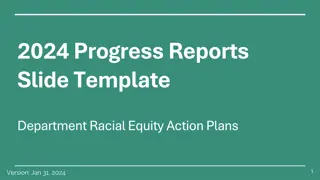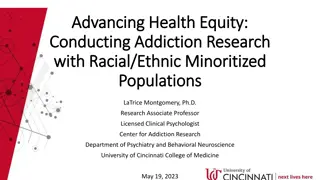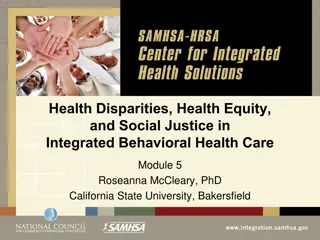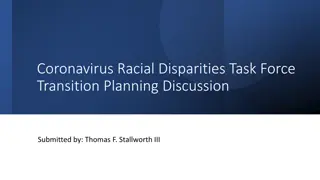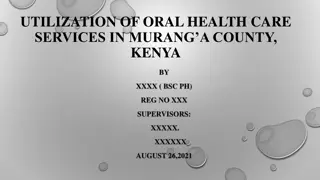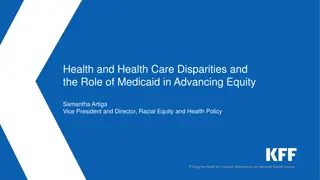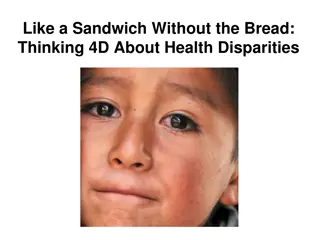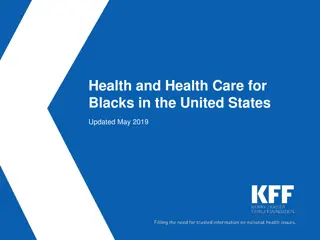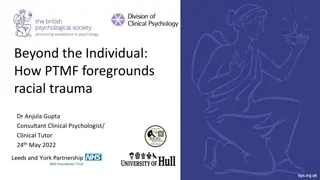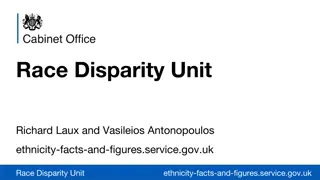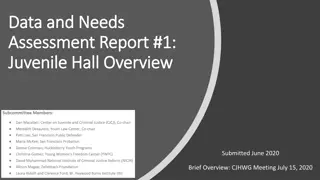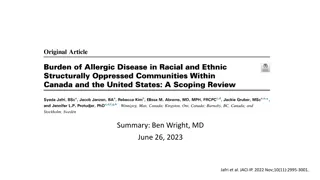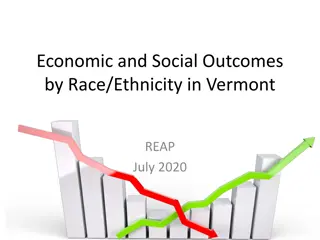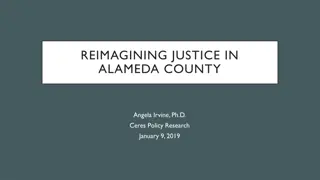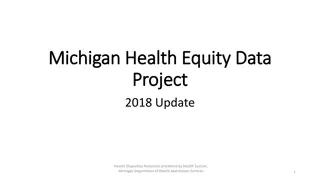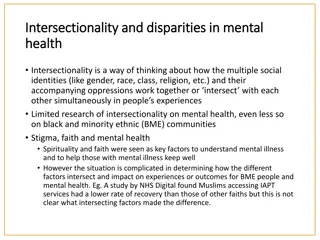Understanding Racial and Ethnic Disparities in Health Care Utilization and Access
This presentation explores disparities in health care access among Medicare beneficiaries, focusing on the impact of loss of Medicaid and supplemental insurance eligibility. It discusses the challenges faced by Black and Hispanic individuals above the Medicaid cutoff, their lower likelihood of having supplemental insurance, and fewer financial resources to cover health care costs. The presentation emphasizes the importance of Medicaid as a key source of supplemental insurance for low-income Medicare beneficiaries.
- Health Care Disparities
- Medicaid
- Supplemental Insurance
- Medicare Beneficiaries
- Racial and Ethnic Disparities
Download Presentation

Please find below an Image/Link to download the presentation.
The content on the website is provided AS IS for your information and personal use only. It may not be sold, licensed, or shared on other websites without obtaining consent from the author. Download presentation by click this link. If you encounter any issues during the download, it is possible that the publisher has removed the file from their server.
E N D
Presentation Transcript
Racial and Ethnic Disparities in Health Care Use Racial and Ethnic Disparities in Health Care Use and Access Associated with Loss of Medicaid and Access Associated with Loss of Medicaid Supplemental Insurance Eligibility Supplemental Insurance Eligibility Eric T. Roberts, Ph.D. National Pepper Center Meeting April 26, 2024
Acknowledgements and Disclosures Presentation summarizes findings from a recent article published in JAMA Internal Medicine with co-authors Renuka Tipirneni, John Ayanian, Michael McWilliams, Alexandra Glynn, and Youngmin Kwon Support from AHRQ (K01HS026727), Pepper Center Pilot (P30AG024827) and NIA grants R01AG076437, P01AG032952, and K08AG056591 This work does not necessarily represent the views of AHRQ or the NIH
Background Medicare beneficiaries face high out-of-pocket health care costs, including cost sharing for: Hospital care: $1,484 deductible/benefit period, daily coinsurance thereafter Outpatient & professional care: annual deductible and 20% coinsurance Prescription drugs: annual deductible plus 25% coinsurance until reaching a catastrophic coverage threshold Medicare beneficiaries can obtain supplemental insurance to cover these costs However, supplemental insurance enrollment varies widely by income, race, and ethnicity
Medicaid Medicaid is a key source of supplemental insurance for low- income Medicare beneficiaries Income cutoff for Medicaid is 100% of FPL Near-poor beneficiaries (incomes >100% to 200% of FPL) often lack alternative supplemental insurance This leads to a Medicaid coverage cliff above 100% of FPL Distribution of supplemental insurance among low-income Medicare beneficiaries Income in percentage points of the Federal Poverty Level (FPL) Source: Authors analyses of the Health and Retirement Study (waves 9-14) linked to Medicare enrollment data.
Medicaid cliff and health care disparities Black and Hispanic beneficiaries above the cutoff for Medicaid are less likely to have supplemental insurance comparable to Medicaid They also have fewer financial resources to pay for health care costs not covered by insurance Proportion of older adults with liquid wealth >$1,000 by race/ethnicity and income level 1 0.9 0.8 Disparities in liquid wealth, conditional on income 0.7 Proportion 0.6 0.5 0.4 0.3 0.2 0.1 0 0 50 Income (percentage points of FPL) 100 150 200 White Black and Hispanic (pooled) Source: Authors analyses of the Health and Retirement Study (waves 9-14).
Objective To evaluate whether this Medicaid cliff differentially affects access to and use of care by race/ethnicity among low-income older adults
Approach Used a regression discontinuity design Idea is to compare people close to, but on either side of, the cutoff Estimated racial/ethnic disparities as a differenceof discontinuities, comparing Black and Hispanic (pooled) to White beneficiaries Used the 2008-2018 biennial waves of HRS (pooled) linked to Medicare enrollment and claims RD estimate Source: Authors analyses of the Health and Retirement Study (waves 9-14).
Results Among Black and Hispanic beneficiaries, cliff was associated with: A 5.7-percentage point increase in difficulty getting care due to cost concerns A 21% relative reduction in annual doctor s office visits Traditional Medicare only Proportion reporting difficulty Annual services/person Legend: Black and Hispanic beneficiaries (pooled) White beneficiaries
Results Among Black and Hispanic beneficiaries, cliff was associated with: A 15% relative reduction in total annual medication fills 11% relative reduction in filling of medications for managing chronic conditions Annual fills/person Annual fills/person Legend: Black and Hispanic beneficiaries (pooled) White beneficiaries
Policy implications Findings highlight concerns about equitable access to care among Medicare beneficiaries because of gaps in supplemental insurance Among Black and Hispanic Medicare beneficiaries, there is a mismatch between needs for care and the ability to pay for care Loss of Medicaid eligibility widens these disparities Wealth disparities among Medicare beneficiaries (median household wealth) Health disparities among Medicare beneficiaries Source: Ochieng et al. Racial and Ethnic Health Inequities and Medicare, Kaiser Family Foundation, February 2021.
Policy implications Targeted policies to broaden Medicaid eligibility may lessen disparities in care among Medicare beneficiaries with modest incomes Options: 1) Broaden eligibility Medicaid supplemental insurance to include near-poor Medicare beneficiaries (e.g., those with incomes of up to 150% or 200% FPL) 2) Taper Medicaid s cost sharing assistance so that out-of-pocket costs rise gradually with income (avoiding a coverage cliff)
Thank you Please reach out! @eric_t_roberts eric.roberts@pennmedicine.upenn.edu


